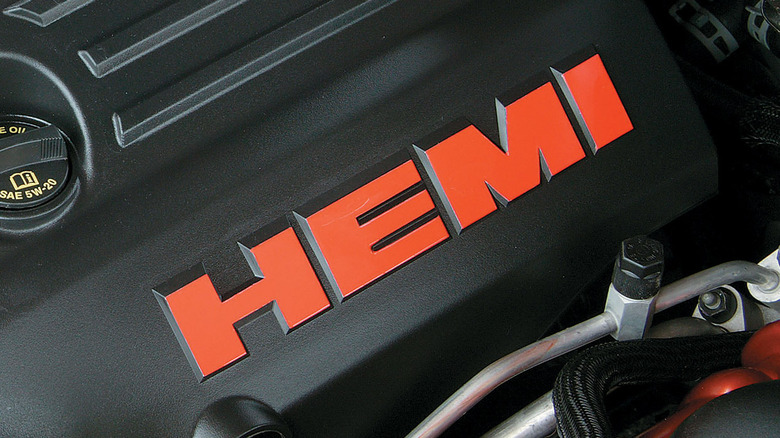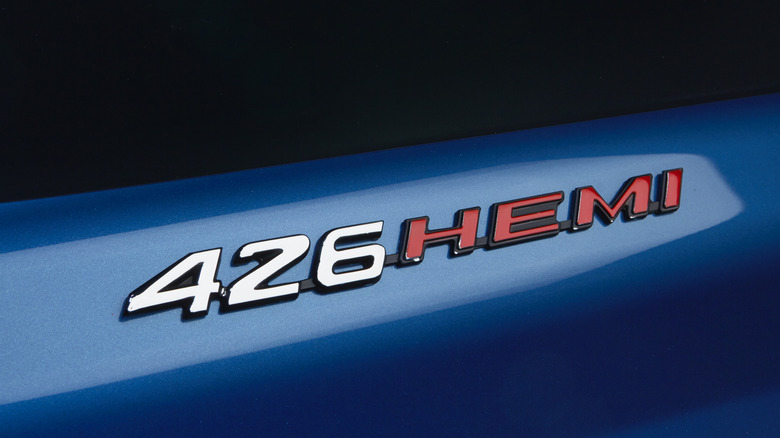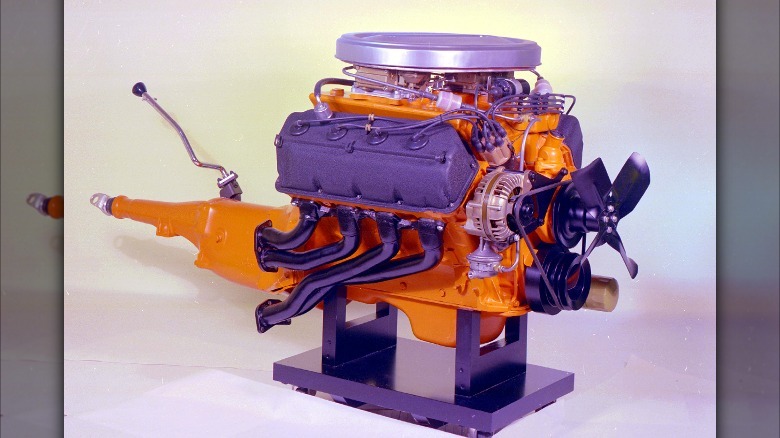Here's What Make Chrysler's HEMI Engines So Special
When it comes to engines that are capable of putting out more horsepower than reason would dictate, Detroit's Big Three automakers provide more than their fair share of offerings: Ford has the Coyote 5.0-liter V8, an upgraded version of the "5.0" seen in many Mustangs since time immemorial (via Ford Authority). GM Performance Motors has the LS V8. In its stock form, the LS can be found in the engine bays of new Camaros and Corvettes. But the venerable LS has been shoehorned into just about anything capable of having a transmission from history-making Mazda Miatas to boats, according to Holley.
Not to be left out of the party, Dodge has been putting a supercharger on nearly its entire lineup for years now to the point where even Jeeps and Ram trucks have joined in on the forced induction fun. At the heart of those 700+ horsepower insurance nightmares is the HEMI engine, Chrysler's seismic addition to the engine world. Chrysler has been engineering the HEMI to throw down rubber for several decades.
Aircraft engines make way for the Street Hemi
The HEMI gets its name from the fact that it uses hemispherical combustion chambers in the engine. The hemispherical shape allows for more volume in the top of the piston inside an engine, and therefore more combustion. That combustion boils down to more engine power (via HowStuffWorks). That extra power was Chrysler's secret weapon for years. Technically speaking, the design first came around at the turn of the 20th century. Chrysler first started tinkering around with HEMIs in aircraft engines towards the end of World War II and then started putting them into automotive use in the early 1950s (via MotorTrend).
In its first iteration, Chrysler's HEMI went by different names, including "Firepower," "Fire Dome," and "Power Giant." First-generation HEMIs topped out at 392 cubic inches, according to MotorTrend. While that is undoubtedly a large engine, it's still much smaller than the second run of HEMI engines that debuted in 1964. At 426 cubic inches (nearly 7 liters), the engine was officially dubbed the "Street Hemi." This is the engine that powered cars that changed the landscape of not just commercial muscle cars, but motorsport vehicles like the Dodge Charger, Plymouth HEMI 'Cuda, and Dodge Challenger of the late 1960s and early 1970s.
Racing pedigree aside, the Street Hemi became the dream engine for poorly thought-out engine swaps and homebrew drag car monstrosities long before the Chevy LS was even a concept. An actual 426 Hemi may have been easier to come across in the 1960s than today, as Street Hemis from this era are not cheap in the 21st century (per Bring a Trailer).
The HEMI's days could be numbered
In the Malaise era of the 1970s and 80s, Chrysler did not offer any V8s sporting the HEMI moniker, but by the time the 2000s came, according to Stellantis, the age of the HEMI was back to terrorize homeowner associations and tear up mall parking lots. Today, you'll find the HEMI badge on just about every muscle car and truck that Chrysler's range of brands is responsible for. It's become synonymous with speed, power, and questionable financial decisions in the name of going fast.
Today's HEMIs are incredibly versatile and come in a variety of displacements: from the commonplace 5.7-liter that sits in a Ram 1500 truck that would be at home on nearly every construction site on the planet, to the supercharged 7-liter "Hellephant" crate engine (via Stellantis).
Unfortunately, the future is not bright for HEMI engines as the Dodge Charger, Challenger, and Chrysler 300 are set to soon become discontinued, leaving only a few SUVs and trucks to bear the HEMI torch. As Stellantis vows to move towards more electrified options in the Ram lineup (alongside similar moves by other major manufacturers), a new performance HEMI from its original makers may not come to pass.



